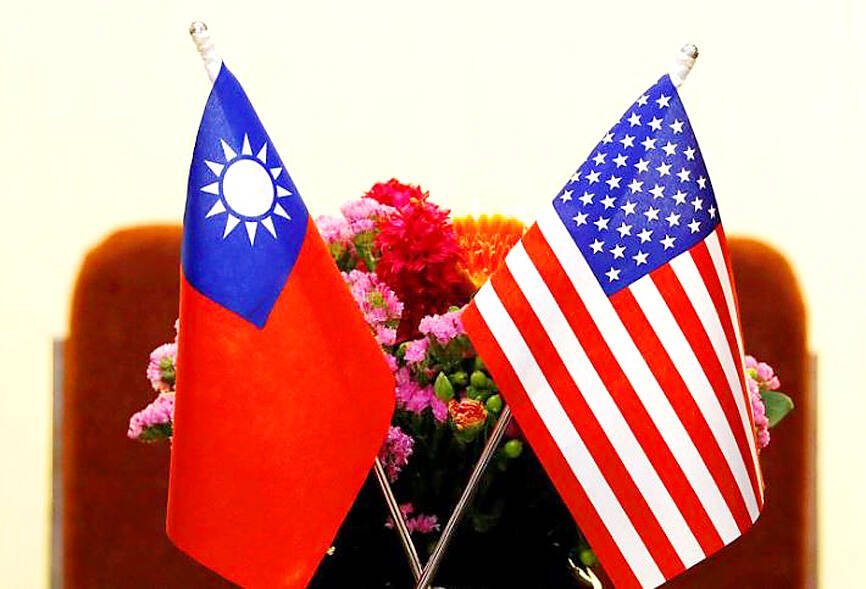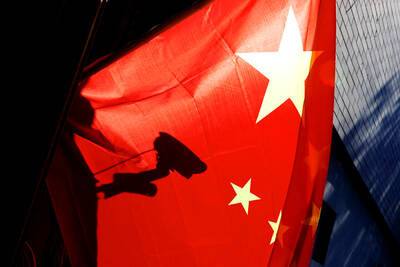The US on Friday announced US$345 million in military aid for Taiwan, in what was Washington’s first major package drawing on the US’ own stockpiles to help Taiwan counter China.
The White House’s announcement said the package would include defense, education and training for Taiwanese.
Washington is to send portable air defense systems, intelligence and surveillance capabilities, firearms and missiles, said two US officials who spoke on the condition of anonymity to discuss sensitive matters ahead of the announcement.

Photo: Tyrone Siu, Reuters
US lawmakers have been pressuring the Pentagon and the White House to speed weapons to Taiwan. The goals are to help it counter China and to deter Beijing from considering attacking, by providing Taipei enough weaponry that it would make the price of invasion too high.
While Chinese diplomats protested the move, Taiwan’s trade office in Washington said the US decision to pull arms and other materiel from its stores provided “an important tool to support Taiwan’s self-defense.”
In Taipei, Presidential Office spokesperson Lin Yu-chan (林聿禪) expressed Taiwan’s gratitude to the US for fulfilling its promise regarding Taiwan’s security, adding it would work to deepen bilateral ties and promote peace, stability and the “status quo” across the Taiwan Strait.
The Ministry of National Defense also expressed its appreciation in a statement, thanking “the US for its firm commitment to Taiwan’s security.”
“The Presidential Drawdown Authority is an important tool to shore up Taiwan’s self-defense capabilities besides arms sales,” Ministry of National Defense spokesman Major General Sun Li-fang (孫立方) said in a statement.
The Ministry of Foreign Affairs thanked the US for honoring its pledges to uphold Taiwan’s security under the Taiwan Relations Act and the Six Assurances. It said that similar to arms sales, the Presidential Drawdown Authority is crucial to bolstering Taiwan’s self-defense.
“Taiwan and the US will continue deepening their close partnership and work together to defend the rule-based international order and promote peace, stability and the status quo in the Taiwan Strait and the Indo-Pacific region,” the ministry said in a statement.
The package is in addition to nearly US$19 billion in military sales of F-16s and other major weapons systems that the US has approved for Taiwan. Delivery of those weapons has been hampered by supply chain issues that started during the COVID-19 pandemic and have been exacerbated by Russia’s invasion of Ukraine.
The new aid is part of a presidential authority approved by the US Congress last year to draw weapons from current US military stockpiles — so Taiwan would not have to wait for military production and sales. This gets weapons delivered faster than providing funding for new weapons.
The Pentagon has used a similar authority to get billions of dollars worth of munitions to Ukraine.
Getting stockpiles of weapons to Taiwan before an attack is one of the lessons the US has learned from Russia’s invasion of Ukraine, US Deputy Secretary of Defense Kathleen Hicks said earlier this year.
Ukraine “was more of a cold-start approach than the planned approach we have been working on for Taiwan, and we will apply those lessons,” Hicks said.
Efforts to resupply Taiwan after a conflict erupted would be complicated because it is an island, she said.
Additional reporting by Su Yung-yao

SECURITY: As China is ‘reshaping’ Hong Kong’s population, Taiwan must raise the eligibility threshold for applications from Hong Kongers, Chiu Chui-cheng said When Hong Kong and Macau citizens apply for residency in Taiwan, it would be under a new category that includes a “national security observation period,” Mainland Affairs Council (MAC) Minister Chiu Chui-cheng (邱垂正) said yesterday. President William Lai (賴清德) on March 13 announced 17 strategies to counter China’s aggression toward Taiwan, including incorporating national security considerations into the review process for residency applications from Hong Kong and Macau citizens. The situation in Hong Kong is constantly changing, Chiu said to media yesterday on the sidelines of the Taipei Technology Run hosted by the Taipei Neihu Technology Park Development Association. With

A US Marine Corps regiment equipped with Naval Strike Missiles (NSM) is set to participate in the upcoming Balikatan 25 exercise in the Luzon Strait, marking the system’s first-ever deployment in the Philippines. US and Philippine officials have separately confirmed that the Navy Marine Expeditionary Ship Interdiction System (NMESIS) — the mobile launch platform for the Naval Strike Missile — would take part in the joint exercise. The missiles are being deployed to “a strategic first island chain chokepoint” in the waters between Taiwan proper and the Philippines, US-based Naval News reported. “The Luzon Strait and Bashi Channel represent a critical access

‘FORM OF PROTEST’: The German Institute Taipei said it was ‘shocked’ to see Nazi symbolism used in connection with political aims as it condemned the incident Sung Chien-liang (宋建樑), who led efforts to recall Democratic Progressive Party (DPP) Legislator Lee Kun-cheng (李坤城), was released on bail of NT$80,000 yesterday amid an outcry over a Nazi armband he wore to questioning the night before. Sung arrived at the New Taipei City District Prosecutors’ Office for questioning in a recall petition forgery case on Tuesday night wearing a red armband bearing a swastika, carrying a copy of Adolf Hitler’s Mein Kampf and giving a Nazi salute. Sung left the building at 1:15am without the armband and apparently covering the book with a coat. This is a serious international scandal and Chinese

COUNTERINTELLIGENCE TRAINING: The ministry said 87.5 percent of the apprehended Chinese agents were reported by service members they tried to lure into becoming spies Taiwanese organized crime, illegal money lenders, temples and civic groups are complicit in Beijing’s infiltration of the armed forces, the Ministry of National Defense (MND) said in a report yesterday. Retired service members who had been turned to Beijing’s cause mainly relied on those channels to infiltrate the Taiwanese military, according to the report to be submitted to lawmakers ahead of tomorrow’s hearing on Chinese espionage in the military. Chinese intelligence typically used blackmail, Internet-based communications, bribery or debts to loan sharks to leverage active service personnel to do its bidding, it said. China’s main goals are to collect intelligence, and develop a